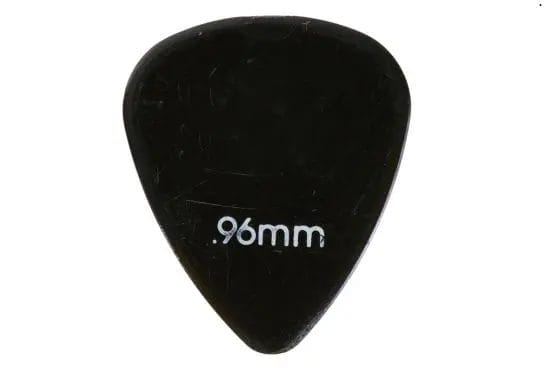Choosing the right guitar pick size can greatly influence your playing style and comfort. Different sizes offer unique benefits and challenges. While thin picks provide flexibility for strumming, thicker picks give better control for solos. Balancing these factors helps you find the perfect pick for your needs.
Guitar Pick Size Chart
| Pick Model | Top to Bottom (mm) | Grip Surface (mm) | Shoulder L to R (mm) | Grip Surface 2 (mm) | Pick Thickness (mm) |
|---|---|---|---|---|---|
| Light 2.2 | 31.6 | 27.6 | 27.2 | 24.2 | 2.2 |
| Regular 2.6 | 31.6 | 27.5 | 27.2 | 24.1 | 2.6 |
| Shredder 2.4 | 27.5 | 24.0 | 24.0 | 20.0 | 2.4 |
| Shredder 3.5 | 27.5 | 22.0 | 24.0 | 19.5 | 3.5 |
| Badazz III 2.0 | 26.4 | 22.4 | 25.5 | 22.2 | 2.0 |
| Badazz III 2.5 | 26.4 | 22.3 | 25.5 | 22.1 | 2.5 |
| Badazz III 3.2 | 26.4 | 22.1 | 25.5 | 22.0 | 3.2 |
| Bermuda III 2.1 | 27.2 | 25.3 | 28.6 | 24.9 | 2.1 |
| Bermuda III 2.7 | 27.2 | 25.2 | 28.6 | 24.8 | 2.7 |
| Bermuda III-P 2.1 | 28.0 | 23.0 | 30.0 | 25.0 | 2.1 |
| Bermuda III-P 2.7 | 28.0 | 22.9 | 30.0 | 24.9 | 2.7 |
| Bermuda III-XL 2.1 | 33.0 | 30.0 | 23.0 | 27.0 | 2.1 |
Why Guitar Pick Size Matters
The size of your guitar pick is crucial because it affects the sound, playability, and overall feel of your guitar playing experience. When choosing a pick, you must balance different factors. For instance, thin picks are flexible and great for strumming, but they may lack control for intricate solos.
On the other hand, thick picks offer precision and a robust tone but can be harder to maneuver for fast strumming. Considering these tradeoffs helps you select the pick that enhances your playing style.
Additionally, trying different sizes can be challenging, but it’s essential to finding the perfect fit. Understanding the impact of pick size on your sound and playability is vital for making the right choice.

Types of Guitar Picks
Guitar picks come in various shapes and sizes, each designed to cater to different playing styles and preferences. When selecting a pick, understanding the tradeoffs between different types is essential.
Thin Picks
Thin picks, typically ranging from 0.38mm to 0.60mm, are ideal for strumming and producing a bright, light tone. However, their flexibility can make precise picking more challenging. While they enhance rhythm playing with a smooth, airy sound, they may not offer the control needed for complex solos.
Medium Picks
Medium picks, usually between 0.60mm and 0.80mm, offer a balanced option for both strumming and picking. These picks strike a good compromise between flexibility and control, making them versatile for various playing styles. Though they provide better control than thin picks, they might not deliver the same robust tone as thicker options.
Thick Picks
Thick picks, often 0.80mm and above, provide better control and are favored by lead guitarists for their robust sound. These picks excel in delivering precise, powerful notes but can be harder to maneuver for fast strumming. The increased control comes at the cost of flexibility, which can impact fluid strumming patterns.
Understanding these differences and experimenting with various picks will help you find the perfect fit for your playing style. Consider the impact of each type on your sound and technique to make an informed decision.
Material and Grip
The material and grip of a guitar pick also play a significant role in its performance and durability. These factors influence not only the feel of the pick but also its sound and longevity.
Common Materials
Guitar picks are made from various materials like plastic, nylon, and metal, each affecting the pick’s flexibility and tone. For example, plastic picks are widely used due to their affordability and availability, but they might wear out quickly. Nylon picks, on the other hand, offer more durability and a smoother feel, making them a popular choice among many guitarists.
Metal picks produce a bright, sharp tone and are extremely durable, yet they can be harsh on the guitar strings. Balancing these material options involves considering the tone you desire and the lifespan of the pick.
Grip Enhancements
Some picks feature textured grips or holes to prevent slipping and provide a more secure hold during play. While textured grips can improve your control and precision, they might feel uncomfortable to some players. Picks with holes offer an innovative solution to grip issues but can alter the pick’s weight and balance.
These grip enhancements can help maintain a steady hold, especially during intense playing sessions. However, finding the right balance between comfort and security can be challenging.
When choosing a guitar pick, consider how the material and grip enhancements will impact your playing style and overall experience. These factors can significantly influence your comfort and performance, making it essential to experiment and find the perfect combination for your needs.

How to Choose the Right Pick for You
Selecting the right guitar pick involves considering your playing style, the type of music you play, and personal preference. Making the right choice can enhance your performance and comfort.
Consider Your Playing Style
If you play mostly rhythm guitar, a thin to medium pick might suit you best for smoother strumming. Thin picks offer flexibility and produce a bright tone, making them ideal for strumming chords. However, they may lack the control needed for precise picking.
Medium picks provide a balanced option, offering both flexibility for strumming and enough rigidity for some picking. This tradeoff makes them versatile for various styles, though they may not excel in either extreme.
Experiment with Different Sizes
Trying out various pick sizes and materials can help you find the perfect fit for your playing style. While thick picks provide excellent control and a robust tone for lead playing, they can be cumbersome for fast strumming. Conversely, thin picks are great for rhythm but might not deliver the power required for solos.
Experimenting allows you to understand how each pick size and material affects your sound and playability. The challenge lies in balancing these factors to find the pick that complements your music and technique.
Considering these aspects and experimenting with different picks will help you make an informed decision. The right pick can significantly impact your playing experience, so take the time to explore your options and find the one that feels just right.
Tips for Beginners
For beginners, starting with a medium pick can offer a good balance and versatility as you develop your playing technique. A medium pick provides a compromise between flexibility and control, making it suitable for a variety of playing styles. As you become more comfortable with the guitar, you can experiment with different sizes and materials to discover what works best for you.
When beginning, it’s important to understand the tradeoffs between different pick sizes. Thin picks are great for strumming and are easier to handle, but they might not offer the precision needed for intricate picking. On the other hand, thick picks provide better control and a fuller tone but can be challenging to maneuver for fast strumming.
Transitioning from a medium pick to other sizes should be a gradual process. Start with a pick that feels comfortable and allows you to focus on your technique without being distracted by equipment issues. As you gain experience, you can explore picks of varying thicknesses and materials to refine your sound and playing style.
By considering these factors and practicing with different picks, you’ll find the one that best suits your evolving needs. The right pick can enhance your playing experience, so take the time to explore your options and choose one that complements your growth as a guitarist.
Conclusion
Understanding guitar pick sizes and their impact on your playing can enhance your musical expression and comfort. By balancing factors like thickness and material, you can address tradeoffs between flexibility and control. Experimenting with different picks helps you find the best fit, ultimately improving your overall playing experience.
FAQs
What is the best pick size for beginners?
The best pick size for beginners is typically a medium pick. It offers a good balance of flexibility and control, making it versatile for various playing styles and helping you develop your technique without being overwhelmed by the extremes of pick sizes.
How does pick thickness affect the tone of my guitar?
Pick thickness affects the tone by influencing how much the pick flexes and impacts the strings. Thinner picks produce a lighter, brighter tone ideal for strumming, while thicker picks deliver a fuller, warmer tone suitable for lead playing. Each thickness can alter the sound and playability of your guitar.
What materials are best for guitar picks?
Common materials for guitar picks include plastic, nylon, and metal. Plastic picks are affordable and versatile, nylon picks offer durability and a smooth feel, and metal picks provide a bright, sharp tone with excellent durability. Each material impacts the pick’s flexibility and sound differently.
How can I prevent my pick from slipping during play?
To prevent slipping, look for picks with textured grips or those with holes designed for a secure hold. These enhancements help you maintain control, especially during fast or intense playing. Experiment with different grips to find what works best for you.
Should I use different picks for different genres of music?
Yes, different genres often benefit from different pick types. For instance, light picks are great for strumming in acoustic or folk music, while heavy picks are preferred for precise lead guitar work in rock or metal. Choosing the right pick can enhance your sound and playing technique.